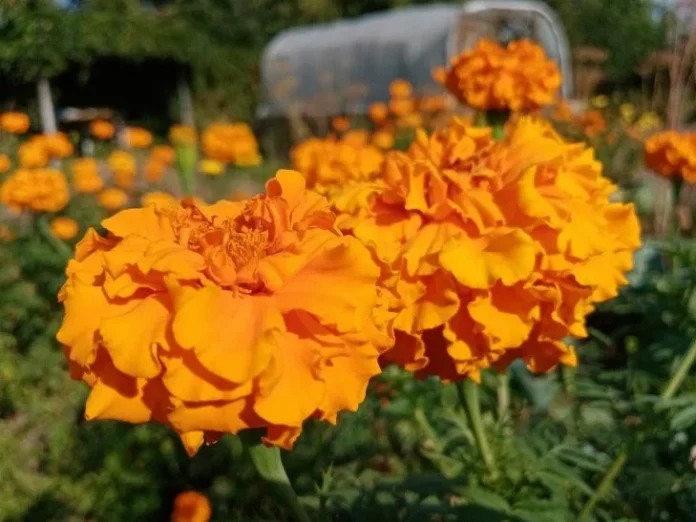You shouldn’t throw away marigolds after they’ve bloomed – any experienced gardener knows that.
This is not a plant that can live out its days on a compost heap or in a pit. If you know what you’re doing, you can make a wonderful pest control product from marigolds.
How to proceed
Marigolds repel pests during bloom, but they don’t become less useful after they fade.
In their composition, marigolds are close to green manure and remain useful even when they stop growing.
How to proceed
The marigold bushes need to be collected and chopped in any convenient way along with the root, inflorescence and stem.
The prepared greens are evenly distributed over the beds, after which they are dug up or embedded in the soil in another convenient way to a depth of 20 cm.
It is believed that after such treatment of the beds, you can not be afraid of pest attacks on carrots, cabbage, strawberries and tomatoes.
Marigolds are excellent repellers of various fleas, aphids and other insects.
You shouldn’t throw away marigolds after they’ve bloomed – any experienced gardener knows that.
This is not a plant that can live out its days on a compost heap or in a pit. If you know what you’re doing, you can make a wonderful pest control product from marigolds.
How to proceed
Marigolds repel pests during bloom, but they don’t become less useful after they fade.
In their composition, marigolds are close to green manure and remain useful even when they stop growing.
How to proceed
The marigold bushes need to be collected and chopped in any convenient way along with the root, inflorescence and stem.
The prepared greens are evenly distributed over the beds, after which they are dug up or embedded in the soil in another convenient way to a depth of 20 cm.
It is believed that after such treatment of the beds, you can not be afraid of pest attacks on carrots, cabbage, strawberries and tomatoes.
Marigolds are excellent repellers of various fleas, aphids and other insects.
You shouldn’t throw away marigolds after they’ve bloomed – any experienced gardener knows that.
This is not a plant that can live out its days on a compost heap or in a pit. If you know what you’re doing, you can make a wonderful pest control product from marigolds.
How to proceed
Marigolds repel pests during bloom, but they don’t become less useful after they fade.
In their composition, marigolds are close to green manure and remain useful even when they stop growing.
How to proceed
The marigold bushes need to be collected and chopped in any convenient way along with the root, inflorescence and stem.
The prepared greens are evenly distributed over the beds, after which they are dug up or embedded in the soil in another convenient way to a depth of 20 cm.
It is believed that after such treatment of the beds, you can not be afraid of pest attacks on carrots, cabbage, strawberries and tomatoes.
Marigolds are excellent repellers of various fleas, aphids and other insects.
You shouldn’t throw away marigolds after they’ve bloomed – any experienced gardener knows that.
This is not a plant that can live out its days on a compost heap or in a pit. If you know what you’re doing, you can make a wonderful pest control product from marigolds.
How to proceed
Marigolds repel pests during bloom, but they don’t become less useful after they fade.
In their composition, marigolds are close to green manure and remain useful even when they stop growing.
How to proceed
Marigold bushes should be collected and chopped in any convenient way along with the root, inflorescence and stem.
The prepared greens are evenly distributed over the beds, after which they are dug up or embedded in the soil in another convenient way to a depth of 20 cm.
It is believed that after such treatment of the beds, you can not be afraid of pest attacks on carrots, cabbage, strawberries and tomatoes.
You shouldn’t throw away marigolds after they’ve bloomed – any experienced gardener knows that.
This is not a plant that can live out its days on a compost heap or in a pit. If you know what you’re doing, you can make a wonderful pest control product from marigolds.
How to proceed
Marigolds repel pests during bloom, but they don’t become less useful after they fade.
In their composition, marigolds are close to green manure and remain useful even when they stop growing.
How to proceed
The marigold bushes need to be collected and crushed in any convenient way together with the root, inflorescence and stem.
You shouldn’t throw away marigolds after they’ve bloomed – any experienced gardener knows that.
This is not a plant that can live out its days on a compost heap or in a pit. If you know what you’re doing, you can make a wonderful pest control product from marigolds.
How to proceed
Marigolds repel pests during bloom, but they are no less useful after they fade.
In their composition, marigolds are close to green manure and remain useful even when they stop growing.
How to proceed
Marigold bushes should be collected and crushed in any convenient way along with the root, inflorescence and stem.
The prepared greens are evenly distributed over the beds, after which they are dug up or embedded in the soil in another convenient way to a depth of 20 cm.
It is believed that after such treatment of the beds, there will be no need to worry about pest attacks on carrots, cabbage,strawberries and tomatoes.
Marigolds are excellent repellers of various fleas, aphids and other insects.


